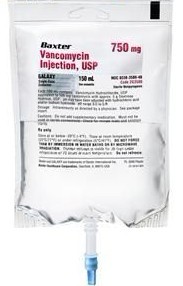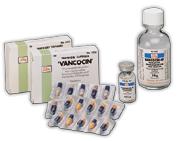750毫克万古霉素注射液,USP
市场上销售:
百特国际公司(迪尔菲尔德,IL)
适应症:
百特国际宣布FDA批准的万古霉素注射液,USP预混料配方,750 mg/150毫升的实力。万古霉素是一种抗生素,用于治疗由耐甲氧西林(β-内酰胺耐药)葡萄球菌敏感菌株引起的严重或严重感染表示。它也表示对青霉素过敏的病人,为病人,谁也不能接收或谁没有回应其他药物,以及vancomycinsusceptible其他抗菌药物有抗药性的生物体引起的感染。万古霉素注射也可500-mg/100-mL和1-g/200-mL优势。
剂型:
预混注射解决方案:750 mg/150毫升
产品名称:注射用盐酸万古霉素
英文名称:Vancomycin Hydrochloride
用途分类:抗菌消炎类/其它
【主要成份】万古霉素盐酸盐
【用 途】
本品适用于耐甲氧西林金黄色葡萄球菌及其他细菌所致的感染:败血症 感染性心内膜炎 骨髓炎 关节炎 灼伤 手术创伤等浅表性激发感染 肺炎 肺脓肿 脓胸 腹膜炎 脑膜炎
【用法用量】
通常用盐酸万古霉素每天2g(效价) 可分为每6小时500mg或每12小时1g 每次静滴在60分钟以上 可根据年龄 体重 症状适量增减 老年人每12小时500mg或每24小时1g 每次静滴在60分钟以上 新生儿每次给药量10-15mg/kg 出生一周内的新生儿每12小时给药一次 出生一周至一月新生儿每8小时给药一次 每次静滴在60分钟以上 配药方法为在含有本品0.5g的小瓶中加入10mL注射用水溶解 在以至少100mL生理盐水或5%葡萄糖注射液稀释 静滴时间在60分钟以上.
产品说明
【药理作用】
抗菌作用:在体外药敏实验中 万古霉素对耐甲氧西林金黄色葡萄球菌(MRSA)有效 与其他种类的抗菌药物无交叉耐药 另外用MRSA在试管内进行传代培养试验其对万古霉素的诱导耐药性也很低 在体外药敏实验中 万古霉素对革兰阴性菌无效 作用机制:万古霉素能够抑制细菌细胞壁的合成 具有杀菌作用 另外还可以改变细菌细胞壁的通透性 阻碍细菌RNA的合成
【不良反应】
报审时在进行安全性评价的107例对象中 发祥其临床检查值异常变化的副作用33例(30.8%) 再审结束时在进行安全性评价的3009例对象中 发现其临床检查值有异常变化的副作用404例(13.43%).(副作用的发生频率根据报审 再审结束时的数据及我公司的研究报告等)重大副作用:
1 休克 过敏样症状(少于0.1%):因为可产生休克 过敏样症状(呼吸苦难 全身潮红 浮肿等) 所以应留心观察 若出现症状则停止给药 采取适当处理措施
2 急性肾功能不全(0.5%) 间质性肾炎(频率不明):因可出现急性肾功能不全 间质性肾炎等重要的肾功能损害 所以有必要进行定期检查 若出现异常最好停止给药 若必须继续用药 则应减低药量慎重给药
3 多种血细胞减少(少于0.1%) 无粒细胞血症 血小板减少(频率不明):因可出现再障 无粒细胞血症 血小板减少 若发现异常则停止给药 采取适当处理措施
4 皮肤粘膜综合症(Stevens-Johnson综合症) 中毒性表皮坏死症(Lyell综合症) 脱落性皮炎(频率不明):因可出现皮肤粘膜综合症(Stevens-Johnson综合症) 中毒性表皮坏死症(Lyell综合症) 脱落性皮炎 所以应留心观察 若出现此种症状则停止给药 采取适当处理措施
5 第8脑神经损伤(少于0.1%):因可出现眩晕 耳鸣 听力低下等第8脑神经损伤症状 所以有必要进行听力检查 而且若上述症状出现最好停止给药 若必须用药 则应慎重给药
6 伪膜性大肠炎(频率不明):因可出现伴有血便的伪膜性大肠炎等严重的肠炎 所以在出现腹痛 腹泻症状时停止给药 采取适当处理措施
7 肝功能损害 黄疸(频率不明):因可出现AST(GOT) ALT(GPT) AFP的上升 黄疸 所以有必要进行定期检查 若出现异常最好停止给药 采取适当处理措施
【禁忌症】
对本品有既往过敏性休克史的患者禁用 下列患者原则不予给药 若有特殊需要需慎重:
1 对本品 替考拉宁 糖肽类抗生素或氨基糖苷类抗生素有既往过敏史患者
2 因糖肽类抗生素 替考拉宁或氨基糖苷类抗生素所致耳聋及其他耳聋患者(可使耳聋加重) 下列患者应慎重给药:
1 肾功能损害患者(因排泄延迟 药物蓄积所以应监测血中药物浓度慎重给药 参见药物动态项)
2 肝功能损害患者(可加重功能损害)
3 老年患者(参见5.老年患者用药 药物动态项)
4 低出生体重儿 新生儿(参见7.儿童用药 药物动态项)
【注意事项】
基本注意事项:
1 本品对耐甲氧西林金黄色葡萄球菌所致感染明确有效,但对葡萄球菌肠炎非口服用药,其有效性尚未明确。
2 用药期间希望能监测血药浓度有关用法和用量:
1 快速推注或短时内静滴本药可使组胺释放出现红人综合症(面部、颈及躯干红斑性充血、瘙痒等)、低血压等副作用,所以每次静滴应在60分钟以上。
2 肾功能损害及老年患者应调节用药量和用药间隔,监测血中药物浓度慎重给药(参见1.慎重给药、5.老年人用药,药物动态)
3 为防止使用本药后产生耐药菌,原则尚应明确细菌的敏感性,治疗时应在必要的最小期间内用药使用上的注意。配药:目前已明确本品与下列注射剂混合使用引起药物变化,所以不能混注。与氨茶碱、5-氟尿嘧啶混合后可引起外观改变,时间延长药物效价可显著降低。
给药:
1 因可引起血栓性静脉炎,所以应十分注意药液的浓度和静滴的速度,再次静滴时应更换静滴部位。
2 药液渗漏于血管外可引起坏死,所以在给药时应慎重,不要渗漏于血管外。给药途径:肌肉内注射可伴有疼痛,所以不能肌注。其他注意事项:国外有快速静滴本药引起心跳停止的报道。
【药物相互作用】暂不明确
【贮藏方法】室温(1至30°C)下保存。
【规格】
万古霉素胶囊125mg, 250mg; 万古霉素注射液 1g/20mL, 500mg/10mL。
 |
VancomycinVANCOCIN® (Vancomycin Hydrochloride Capsules, USP)
The following information is intended for use by viewers in the United States.
VANCOCIN® is indicated for the treatment of Clostridium difficile-associated diarrhea (CDAD). Vancocin is also used for the treatment of enterocolitis caused by Staphylococcus aureus (including methicillin-resistant strains). Vancocin is contraindicated in patients who have experienced a hypersensitivity to vancomycin. Vancocin must be given orally for treatment of staphylococcal enterocolitis and CDAD. Orally administered Vancocin is not effective for other types of infections. Clinically significant serum concentrations have been reported in some patients who have taken multiple oral doses of Vancocin for active CDAD. Monitoring of serum concentrations may be appropriate in some instances.
Nephrotoxicity has occurred following oral Vancocin therapy and can occur either during or after completion of therapy. The risk is increased in geriatric patients. Monitor renal function. Ototoxicity has occurred in patients receiving Vancocin. Assessment of auditory function may be appropriate in some instances. Prescribing Vancocin in the absence of a proven or strongly suspected bacterial infection is unlikely to provide benefit to the patient and increases the risk of the development of drug resistant bacteria. In clinical trials, the most common adverse reactions (greater than or equal to 10 percent) were nausea (17 percent), abdominal pain (15 percent), and hypokalemia (13 percent). Patients over 65 years of age may take longer to respond to therapy compared to patients less than 65 years of age. Clinicians should be aware of the importance of appropriate duration of Vancocin treatment in patients over 65 years of age and not discontinue or switch to alternative treatment prematurely.
Drug Class
Vancomycin is classified as a Stage II cell wall biosynthesis inhibitor. It kills bacteria and is therefore labeled as a bactericidal agent. Due to its large molecular size and lipophilicity, vancomycin is only effective against gram positive bacteria. The drugs lipophilic characteristic allows it to diffuse through the highly lipophilic bacterial cell wall of gram positive organisms. Gram negative bacteria have membrane proteins called porins. These porins allow polar particles to pass through but due to vancomycins highly lipophilic nature it is unable to enter gram negative bacteria.
Clinical Use
Dosing
Vancomycin can be used both orally and parenterally. Oral preparations are used for their local effect on infections of the gastrointestinal tract. Vancomycin should be given through intravenous administration for other systemic effects against bacterial diseases.
GI tract infections: 500mg-2g orally, daily in divided doses every 6-8 hours for 7-10 days (adult); 40mg/kg/day orally in divided doses every 6-8 hours (pediatrics)
Bacterial infections: 2g/day IV divided every 6-12 hours (adults); 10-15 mg/kg IV every 6-8 hours; maximum 2g/day (pediatrics)
Adverse Events
Some common adverse effects are drug-induced, widespread reddening of the skin (erythroderma) and nausea and vomiting. The erythroderma is commonly called "Red Man Syndrome" and is associated with the rate of infusion. This reaction can be avoided if the rate of infusion is reduced.
There are some serious side effects that can occur but are relatively rare: neutropenia, anaphylaxis, ototoxicity, and nephrotoxicity.
Drug Interactions
Vancomycin may have drug-drug interactions with: Amikacin, Gentamicin, Succinylcholine, and Warfarin. Amikacin and Gentamicin are aminoglycosides and are known to cause nephrotoxicity. It would be prudent to avoid using Vancomycin and aminoglyosides together because of the increased risk of nephrotoxicity due to the fact that both types of agents can cause renal toxicity. Vancomycin can potentiate the neuromuscular blockade brought on by Succinylcholine. Vancomycin increases the risk of bleeding in patients who are taking warfarin.
Pregnancy Category
Vancomycin is a pregnancy category C drug. Therefore, it should not be given parenterally unless the benefit justifies the risk to the fetus. Vancomycin is excreted into the breast milk as well so nursing mothers should not nurse while they are being treated with Vancomycin. When given orally, Vancomycin is not readily absorbed but it is not known whether the oral formulation is excreted into the breast milk.
Mechanism of Action
Vancomycin is a stage II cell wall biosynthesis inhibitor. It acts by forming three hydrogen bonds to the D-Alanyl-D-Alanine portion of the dipeptide at the end of the chains and prohibits the chain from being transported to the cell wall for cross linking. Bacterial cell walls require a very strong wall made up of cross-linking chains of N-Acetyl Glucosamide (NAG) and N-Acetyl muramic acid. The backbone of this cross linked system is peptidoglycan. This cell wall is an absolute requirement due to the fact that gram positive bacteria have a very hypotonic environment and they will be destroyed if their cell wall defense system is incorrectly assembled. By inhibiting the transport of the chains to the cell wall, vancomycin disrupts the construction of the cell wall and the bacteria explode due to the osmotic pressure.
Resistance
Resistance to Vancomycin occurs when a single position is changed in the D-Ala-D-Ala portion of the chain. Resistant bacteria change an N to an O and that change eliminates one hydrogen bond. Without all three hydrogen bonds the binding of Vancomycin to D-Ala-D-Ala is too weak and the chain can easily be transported to the cell membrane for construction.
Future Use
Although Vancomycin continues to be useful in the treatment of gram positive organisms that are resistant to other forms of treatment, the drug's usefulness will steadily begin to decline. It has been overused for a number of years and the number of patients in hospitals who are infected with bacteria that are resistant to Vancomycin continues to grow.



